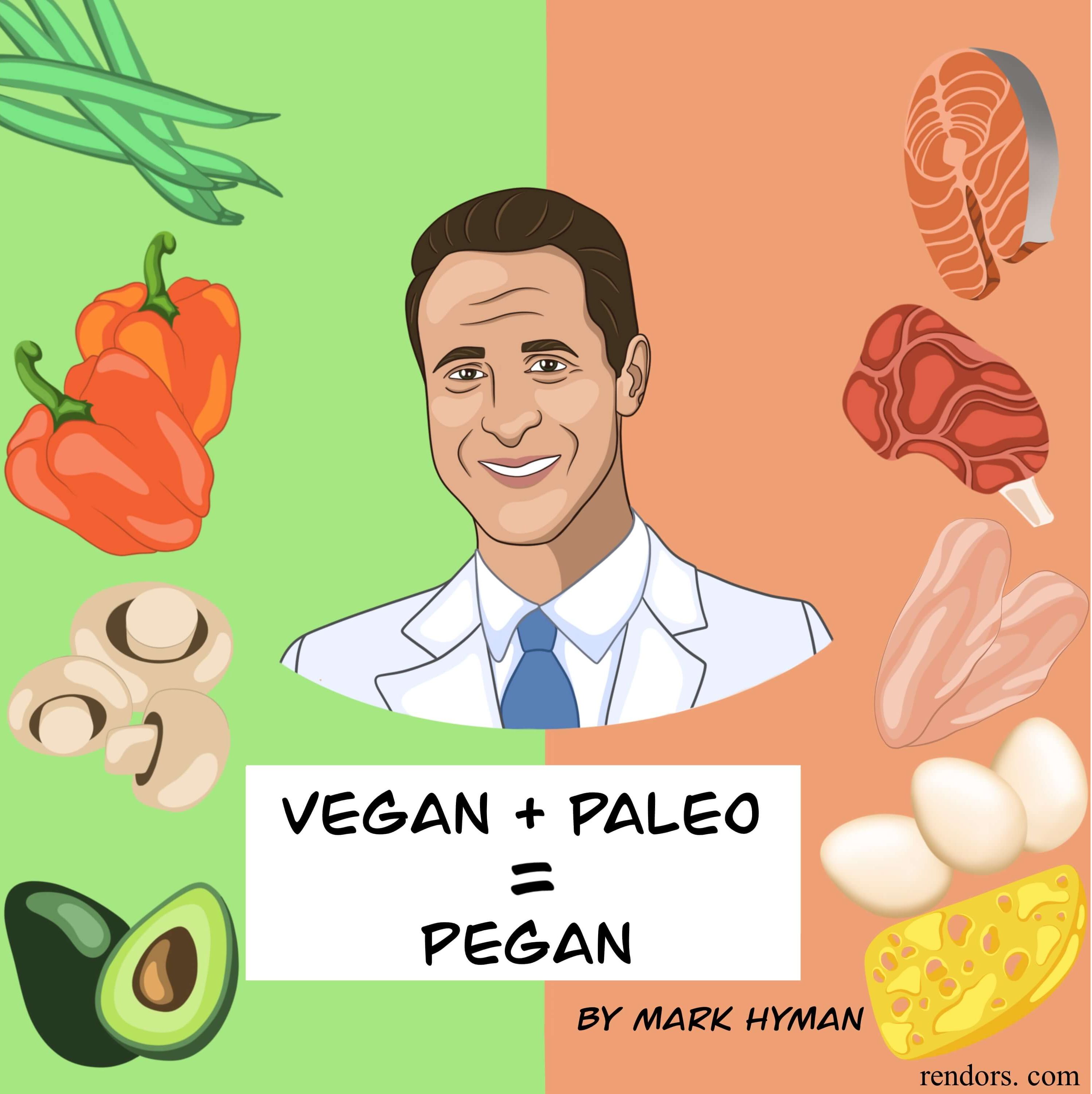Don't see an advisor you admire? Let's add him to the database! - Request

Dr. Hyman's Food Philosophy. The Essence of Pegan Diet and No-Nonsense Advice on How to Eat Better
Mark Hyman is the man on a mission of combining science, common sense, and concern for your tastebuds into a comprehensive wholesome easy-to-follow diet. He is a prolific and renowned writer. Below I will present you with a quick introduction to his food philosophy based on scientific facts and extensive experience.
Vegan, Paleo, and… Pegan?
The vegan diet constitutes eating only plant-based foods, in other words, avoiding any animal products or byproducts. The paleo diet means eating like ancient ancestors from the Paleolithic era (before the birth of agriculture). Back then, the available foods were wild meats, fish, nonstarchy vegetables, root vegetables, nuts, seeds, and seasonal fruits. This diet excludes grains, dairy, legumes, and beans.
Mark Hyman suggests we follow the pegan diet - a mashup of paleo and vegan. And it seems like taking “the best of both worlds” approach can make the diet easier to follow, more nutrient-rich, and simply more delicious.
The only real difference between Vegan and Paleo is whether you eat animal products versus beans and grains as the source of your protein. Mark Hyman
Paleo is usually higher in protein, vitamin B12, and some micronutrients, while vegan provides more fiber and antioxidants. After following each of the diets, Mark Hyman claims to have found the perfect blend. He outlines 10 principles that present the big picture of the pegan diet:
- Plants Should Be the Star of Your Diet. 50-75% of every plate should consist of vegetables. Try to limit the intake of potatoes, sweet potatoes, and winter squash.
- Quality Counts in More Ways Than One. Read the labels. Learn to recognize harmful additives like pesticides, antibiotics, hormones, GMOs, preservatives, dyes, and other chemicals. A good rule of thumb is to buy packaged products with less than 5 ingredients.
- Avoid Gluten and Limit Most Dairy. “Below the neck, your body can’t tell if you just ate a bagel or a bowl of sugar.” Eliminating gluten can lead to reduced inflammation, weight loss, and better gut health. Dairy has hormones that can cause cancer and weight gain. Low-fat versions are even worse. As occasional treats, it is better to choose full-fat options from grass-fed cows. Sheep and goat dairy products are better tolerated and cause less inflammation.
- Limit Gluten-Free Grains Too. Gluten-free grains can still raise blood sugar. Instead, choose foods with a low glycemic index. Some great grains to try are wild black rice, millet, quinoa, teff, buckwheat, and amaranth.
- Avoid Sugar and Eat Fruit in Moderation. Try avoiding anything that might spike blood sugar and increase insulin production.
- Eat Clean Meat, Poultry, and Whole Eggs. “Eating meat won’t clog your arteries, cause cancer, lead to type 2 diabetes, or take years of your life.” What is important, though, is the quality of meat. Choose grass-fed meat and pasture-raised poultry. Go for eggs from pasture-raised hens. Keep in mind that labels like “cage-free” and “vegetarian-fed” can be misleading and don’t necessarily mean that hens had access to the outdoors and a proper diet.
- Choose Low-Mercury, Sustainably Harvested Fish. Buy wild-caught fish. It has lower content of mercury and toxins mainly due to thier smaller size, and therefore less time to accumulate toxins. SMASH fish is best: salmon, mackerel, anchovies, sardines, and herring.
- Eat lots of Healthy Fats. Fat is ok, but it has to be the right type: Omega-3 fats from seafood, nuts, and seeds; monosaturated fats from olive oil and avocados; saturated fats from coconut oil and coconut butter, whole eggs, sustainably raised or grass-fed meats, and grass-fed butter or ghee.
- Vegetable Oils Are Not a Health Food. “Canola, sunflower, corn, grapeseed, safflower, peanut, sunflower, palm, soybean, and vegetable oils are inflammatory and abundant in fried and prepared foods.” Such oils contain Omega 6’s, instead of Omega 3’s and should be avoided
- Enjoy Legumes Once in a While. Lentils and peas are the best legumes. Don’t consume more than ½ cup a day. People with some preexisting health conditions may need to be cautious when consuming legumes.
Let the following Pegan Food Pyramid guide your preferences - the lower the food is, the more of it (as a % of your daily intake) you should eat.
Beyond calorie counting
Not all calories are created equal. Focus on quality, not quantity. If you eat good food, your body will naturally regulate the amount of food you eat.
What about salt?
Some people are genetically salt-sensitive. For others, salt is harmless as long as we keep the ratio of sodium and potassium balanced. The best sources of potassium are cooked spinach, broccoli, squash, and avocados. When adding extra salt to your food, keep in mind that sodium naturally occurs in meat, beet, carrots, celery, seaweed, and beans.
Also, the table salt is highly refined and lacks beneficial minerals. Instead, choose Himalayan pink salt, kosher salt, or sea salt.
Eat the Rainbow.
“Eat an assortment of colorful plant foods daily, and you’ll reap the benefits of numerous phytonutrients, vitamins, and minerals that support optimal health.” Plant colors signal some protective and healing substances.
Which Food Labels Really Matter?
USDA Organic
Certified organic plants are produced without genetic engineering, ionizing radiation, sewage sludge, (most) chemical pesticides, herbicides, and synthetic fertilizers. The land on which the plants are grown has to be free from the prohibited substances for at least 3 years prior to harvest.
Some studies have shown a connection between pesticide exposure and risk of cancer, respiratory problems, depression, and Parkinson’s disease. If you eat all organic, you will be exposed to far fewer pesticides through food.
If you can’t eat 100% organic, check out the prioritized list by the Environmental Working Group. The foods on top of the list are most contaminated (if purchased non-organic), while those at the bottom are ok either organic or not.
NON-GMO
The research is still inconclusive but tends to point out some adverse effects of relying on GMO foods. Why take chances? One way to avoid GMOs is to buy organic. If you can’t get organic, non-GMO is the next best thing.
Grass-Fed or Pasture-Raised
“Grass-fed” label is reserved for beef, bison, goat, lamb, sheep, and dairy products. “Pasture-raised” applies to pork, poultry, and eggs. This label is even better than organic since, in the case of the latter, animals can still be fed cheap corn, which inflames their bodies.
Wild-Caught and Sustainably Harvested Seafood.
Wild-caught is always better than farmed. Eating farmed fish on a regular basis will certainly cause harm to your health. Wild-caught fish has less bad stuff (inflammatory omega-6 fatty acids, dioxins, and polychlorinated biphenyls) and more good stuff like omega-3 fatty acids.
Fair Trade and Rainforest Alliance Certified
By choosing coffee, tea, sugar, and chocolate with such labels, you are making a step towards sustainability and social justice. A certification from the Fair Trade Federation or the Rainforest Alliance ensures no human abuse or unsustainable farming anywhere in the supply chain of a given product.
Final Thoughts
Dr. Hyman believes that modern industrial complexes of food farming, processing, and distribution are broken. The benefits of low prices, long shelf life, and convenience are obvious. What is not obvious is the implicit trade-off we are subjected to. We pay with compromised health and well-being. Eating healthy foods is essential for living a good life. Doing so, despite popular myths, can be delicious, doesn’t have to be excessively expensive, and shouldn’t take all the free time in our busy schedules.
I hope this brief overview of Dr. Hyman’s ideas serves you as an effective introduction and a quick reference for some food-related questions you might have. Also, I hope it inspires you to read some of his books.
Below you can find the books he wrote, the reads he recommends, and the endorsements from outstanding people that he received.
Mark Hyman - books written and endorsements received
P.S.
Quotes and images in this post are taken from the book Food: What the Heck Should I Cook?

